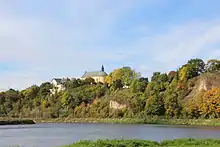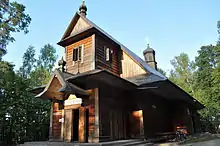Podlachia
Podlachia[1] or Podlasie,[2] (Polish: Podlasie, Belarusian: Падляшша Padliašša, Lithuanian: Palenkė, Ukrainian: Підляшшя Pidliashshia) is a historical region in the eastern part of Poland. Between 1513 and 1795 it was a voivodeship with the capital in Drohiczyn. Now the part north of the Bug River is included in the modern Podlaskie Voivodeship with the capital in Białystok.
Podlachia
Podlasie | |
|---|---|
 Coat of arms | |
 Podlachia Proper | |
| Country | |
| Former capital | Drohiczyn |
| Time zone | UTC+1 (CET) |
| • Summer (DST) | UTC+2 (CEST) |
Names and etymology
The region is called Podlasie, Podlasko or Podlasze in Polish, Palenkė in Lithuanian, Padliašša (Падляшша) in Belarusian, Pidljaššja (Підляшшя), Pidljassja (Підлясся), Pidljasije (Підлясіє), or Pidljaxija (Підляхія) in Ukrainian, Podljas’e (Подлясье) in Russian, "Podlyashe" (פּאָדליאַשע) in Yiddish, and Podlachia in Latin.
There are two opinions regarding the origin of the name of the region. According to the first one, the name is derived from the Polish word las ("forest"), and means "near the forest".[3] Commonly people derive it from the Slavic word les or las meaning "forest", i.e., it is "by the wood(s)" or an "area of forests", making Podlachia close in meaning to adjacent Polesia. The theory has been questioned, as it does not properly take into consideration the vowel shifts "a" > "e" > "i" in various Slavic languages (in fact, it mixes vowels from different languages).
According to the second version, the name is derived from the word liakh (or lach, Ukrainian: лях, "Pole"), and means "near Poland".[3] The second opinion holds that the term comes from the expression pod Lachem, which may be translated literally as "under the Poles" (see: Lechia). Some claim it to mean "under Polish rule", though in the Middle Ages Podlachia was only partially under Polish rule, and since 1446 until 1569 the area belonged to the Grand Duchy of Lithuania. A better variant of this theory holds that the name originates from the period when the territory was within the Trakai Voivodeship of the Grand Duchy of Lithuania, along the borderline with the Mazovia province, primarily a fief of the Poland of the Piasts and later on part of the Kingdom of Poland of the Jagiellons. Hence pod Lachem would mean "near the Poles", "along the border with Poland". The historical Lithuanian name of the region, Palenkė, has exactly this meaning.
Geography

Podlachia is located along the middle stretch of the Bug River between Mazovia in the west, Polesia and Volhynia in the east, the Narew River in the north and the Chełm Land in the south.[3] The borders of Podlachia changed with time and was not the same as historical Podlaskie Voivodeship.[3] Podlachia is sometimes divided into two parts (southern and northern), which had different administrative subordination.[3]
Traditional capital of Podlachia is Drohiczyn that lies into northern and southern parts. The former is included in the modern-day Podlaskie Voivodeship with its capital at Białystok (the historical boundary goes exactly through the city). Sometimes, Siedlce has been considered the capital of the region.
History

Throughout its early history, Podlachia was inhabited by various tribes of different ethnic roots. In the 9th and 10th centuries, the area was inhabited by East Slavs tribes, mostly by Drevlians, with settlements of Dregoviches to the north beyond the Narew River and likely Dulebes to the south.,[3] although Masovian like population had been also present.[4] In the 14th century the area was annexed by the Grand Duchy of Lithuania, though later on it still briefly fell under Mazovian Piast rule. In 1446, Podlachia became part of the Grand Duchy, but since 1496 southwestern parts of Podlachia (Drohiczyn Land and Mielnik Land) and since 1501 the northern part (Bielsk Land) used Polish law instead of Lithuanian. In 1513 King Sigismund I the Old formed the Podlaskie Voivodeship (adjective of Podlasie). In 1566, the southeastern part of Podlachia became part of the newly formed Brest Litovsk Voivodeship as the Brest Litovsk County. In 1569, after the Union of Lublin, Podlasie was ceded to the Kingdom of Poland. It was the northernmost part of the Lesser Poland Province of the Polish Crown. The voivodeship was divided in three lands: the Drohiczyn, Mielnik and Bielsk Land. In the 18th and 19th century the private town of Białystok became the main center of the region, thanks to the patronage of the Branicki family and the textile industry development. After the Third Partition of Poland in 1795, Podlachia was divided between the Kingdom of Prussia, the Habsburg Monarchy and the Russian Empire. In 1807, the western part of Podlachia became part of the Duchy of Warsaw, a semi-independent Polish entity, while the eastern part including Białystok fell under Russian rule.
In 1842 the northern Podlachia (Bielsk Podlaski county) became part of Grodno Governorate, and the southern Podlachia was assigned to Congress Poland of Russian Empire.[3] According to the Russian Imperial Census of 1897, the most spoken languages in Siedlce Governorate (that included southern Podlachia) were Polish (66.13%), Yiddish (15.56%) and Ukrainian (13.95%).[5] At the same time the most spoken languages in Bielsk Podlaski county (northern Podlachia) were Ukrainian (39.1%), Polish (34.9%), Yiddish (14.9%), Russian (5.9%) and Belarusian (4.9%).[6]
In the 19th century the region was a stronghold of Polish resistance against Russian rule. The last partisan of the January Uprising Stanisław Brzóska operated here until 1865. He was hanged publicly by the Russians in Sokołów Podlaski in May 1865. Poland regained Podlachia after restoring independence in 1918.
Demographics
Ethnic situation

While today Podlachia is mostly inhabited by Poles, many Belarusians live in the eastern parts.[7] According to Polish census of 2002, in Podlaskie Voivodeship there were 46,041 Belarusians (3.9%) and 1,366 Ukrainians (0.1%).[8] Autochthonous inhabitants have difficulties in national self-identification and identifying of their language.[9][10] They often identify their nationality as "tutejszy" (literally "locals").[11] Based on comparison of a survey and the census, Marek Barwiński supposes that people with a low level of national identity during the census usually choose the major nationality in their region.[12]
Orthodox autochthonous inhabitants are known as khakhly (without any negative connotations, though today in Ukraine it is known as an ethnic slur for Ukrainians).[13] According to Mykhailo Lesiv, this name appeared after it was used to denote locals in the Russian Imperial Army.[13] Many scientific researches prove that the orthodox population in Podlachia have Ukrainian origin (19th century censuses, historical and linguistic researches), though today the number of people with the Ukrainian identity is very small.[14]
Until the 19th century, Podlachia was populated by the Polish-speaking yeomanry (drobna szlachta), Jews (primarily in towns), and Ruthenian Greek-Catholics speaking a dialect related to modern Ukrainian – the so-called Khakhlak (Chachlak) dialect, which derived its name from a derogatory term for Ukrainians (khakhol or khokhol being the name of the traditional haircut of Ukrainian Cossacks).
In the 19th century, the inhabitants of Podlachia were under the rule of the Russian Empire, with southern Podlachia constituting a part of Russian-controlled Congress Poland. After 1831, Russian authorities forbade the Greek-Catholic faith in northern Podlachia and it disappeared from the area. In 1875, Russians forbade this rite in the southern portion as well, and all Greek-Catholic inhabitants were forced to accept the Eastern Orthodox faith. However, the resistance of the local people was surprisingly strong and Ruthenian speakers from this area rejected the separation from the Pope. In 1874, blessed Wincenty Lewoniuk and 12 companions were killed by Russian soldiers in Pratulin. In reaction to these measures, the Ruthenians of southern Podlachia began to identify themselves with the national movement of the Roman Catholic Poles. To preserve the full communion with the Pope, they changed their rite from Eastern to Latin before the compulsory conversion of Greek Catholics into Orthodox. In 1912, Russian authorities issued a tolerance edict that made it possible to change confession from Orthodox to Roman Catholic (but not to Greek-Catholic, which had been completely deleted). A majority of the inhabitants of southern Podlachia changed their faith from Orthodox to Roman Catholic. At present, very few people in this area speak Ruthenian and nearly all consider themselves Poles. Meanwhile, the eastern part of northern Podlachia is still populated by Belarusians.
Podlachia is also the cultural center of Poland's small Tatar minority as well. After the annexation of eastern Poland into the Soviet Union following World War II, Poland was left with only 2 Tatar villages, Bohoniki and Kruszyniany (both outside the historical borders of Podlachia). Some Tatars from the territories annexed to the USSR have been repatriated to Poland and clustered in cities, particularly Białystok. In 1925 the Muslim Religious Union (Muzułmański Związek Religijny) was formed in Białystok. In 1992, the Union of Tatars of the Republic of Poland (Związek Tatarów Rzeczypospolitej Polskiej) with autonomous branches in Białystok and Gdańsk began operating.
Language
The dominant language in Podlaskie Voivodeship is Polish.[15] Autochthonous inhabitants speak Podlachian subdialects. Many linguists relate them to the Ukrainian language.[16][17] Linguists have been exploring them since 19th century, when they were also known as Siedlce dialects (because of the name of Siedlce Governorate, where the dialects were mostly investigated).[18] There is a problem if they should be considered as part of west Polisian dialects subgroup or as a separate subgroup of northern dialectal group of the Ukrainian language.[19] In the Northern Podlachia Podlachian subdialects are also often considered to be Belarusian dialects[20][18] or sometimes Ruthenian dialects.[21]
Since the locals are known as khakhly, the local language is also called Khakhlatska mova (Ukrainian: хахлацька мова, "khokhols' language").[13] S. Zhelekhov wrote in 1884 that the people call their language "Polesian, but those, who were in the army (in the soldiers) call it Khakhlatska".[22]
Cities and towns
| City | Population (2015/16)[23] | Pop. (1931) | Administrative division | Additional information | |
|---|---|---|---|---|---|
| 1. | Brest | 340,141 | 48,431 | Brest Region | Part of Podlachia until 1566, after 1566 it is rather considered part of Polesia; former royal city of Poland. |
| 2. | Białystok | 295,981 | 91,335 | Podlaskie Voivodeship | Former private town of the Branicki family. |
| 3. | Biała Podlaska | 57,414 | 17,549 | Lublin Voivodeship | Part of Podlachia until 1566, after 1566 it was rather considered part of Polesia, nowadays the area is referred to as Southern Podlachia; former private town of the Radziwiłł family. |
| 4. | Kobryn | 52,655 | 10,101 | Brest Region | Part of Podlachia until 1566, after 1566 it is rather considered part of Polesia. |
| 5. | Augustów | 30,449 | 12,147 | Podlaskie Voivodeship | Former royal city of Poland. |
| 6. | Byaroza | 29,408 | 4,521 | Brest Region | Area was part of Podlachia until 1566, after 1566 it is rather considered part of Polesia. |
| 7. | Bielsk Podlaski | 26,336 | 7,029 | Podlaskie Voivodeship | Former royal city of Poland, capital of Bielsk Land. |
| 8. | Hajnówka | 21,559 | Podlaskie Voivodeship | ||
| 9. | Sokołów Podlaski | 18,720 | 9,901 | Masovian Voivodeship | Former private town of the Kiszka and Radziwiłł families. |
| 10. | Pruzhany | 18,459 | 8,013 | Brest Region | Part of Podlachia until 1566, after 1566 it is rather considered part of Polesia. |
| 11. | Międzyrzec Podlaski | 17,117 | 16,837 | Lublin Voivodeship | Part of Podlachia until 1574, after 1574 it was rather considered part of Polesia, nowadays the area is referred to as Southern Podlachia, former private town. |
| 12. | Łapy | 16,005 | 6,674 | Podlaskie Voivodeship | |
| 13. | Siemiatycze | 14,766 | 6,816 | Podlaskie Voivodeship | Former private town of the Jabłonowski family. |
| 14. | Włodawa | 13,643 | 8,519 | Lublin Voivodeship | Part of Podlachia until 1566, after 1566 it was rather considered part of Polesia, nowadays the area is referred to as Southern Podlasie; former private town. |
| 15. | Zhabinka | 13,357 | Brest Region | Area was part of Podlachia until 1566, after 1566 it is rather considered part of Polesia. | |
| 16. | Węgrów | 12,796 | 9,416 | Masovian Voivodeship | Former private town of the Radziwiłł family, westernmost town of Podlachia. |
| 17. | Malaryta | 11,823 | Brest Region | Area was part of Podlachia until 1566, after 1566 it is rather considered part of Polesia. | |
| 18. | Mońki | 10,352 | Podlaskie Voivodeship | ||
| 19. | Wysokie Mazowieckie | 9,503 | 3,977 | Podlaskie Voivodeship | Former private town. |
| 20. | Kamyenyets | 8,405 | 3,001 | Brest Region | Part of Podlachia until 1566, after 1566 it is rather considered part of Polesia. |
| 21. | Łosice | 7,099 | 5,026 | Masovian Voivodeship | Former royal city of Poland. |
| 22. | Terespol | 5,815 | 2,308 | Lublin Voivodeship | Part of Podlachia until 1566, after 1566 it was rather considered part of Polesia, nowadays the area is referred to as Southern Podlachia; former private town. |
| 23. | Choroszcz | 5,782 | 2,905 | Podlaskie Voivodeship | |
| 24. | Vysokaye | 5,164 | 2,739 | Brest Region | Area was part of Podlachia until 1566, after 1566 it is rather considered part of Polesia. |
| 25. | Ciechanowiec | 4,840 | 4,029 | Podlaskie Voivodeship | Former private town. |
| 26. | Brańsk | 3,867 | 4,204 | Podlaskie Voivodeship | Former royal city of Poland. |
| 27. | Knyszyn | 2,850 | 4,123 | Podlaskie Voivodeship | Former royal city of Poland, royal residence of King Sigismund II Augustus. |
| 28. | Szepietowo | 2,282 | Podlaskie Voivodeship | Youngest town of Podlachia. | |
| 29. | Kosów Lacki | 2,187 | Masovian Voivodeship | ||
| 30. | Drohiczyn | 2,125 | 2,309 | Podlaskie Voivodeship | Historical capital of Podlachia, former royal city of Poland, capital of Drohiczyn Land. |
| 31. | Tykocin | 2,014 | 3,290 | Podlaskie Voivodeship | |
| 32. | Goniądz | 1,900 | 3,449 | Podlaskie Voivodeship | Former royal city of Poland. |
| 33. | Mordy | 1,819 | 3,287 | Masovian Voivodeship | Former private town of the Radziwiłł and Ciecierski families. |
| 34. | Rajgród | 1,626 | 2,432 | Podlaskie Voivodeship | Former royal city of Poland. |
| 35. | Kleszczele | 1,345 | 2,029 | Podlaskie Voivodeship | Former royal city of Poland. |
| 36. | Suraż | 1,008 | 1,379 | Podlaskie Voivodeship | Former royal city of Poland. |
Gallery
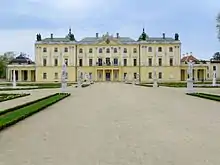 Branicki Palace in Białystok - the largest city of proper Podlachia
Branicki Palace in Białystok - the largest city of proper Podlachia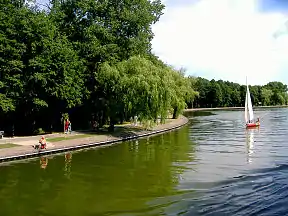 The former royal city of Augustów is the northernmost city of Podlachia and a popular summer tourist destination
The former royal city of Augustów is the northernmost city of Podlachia and a popular summer tourist destination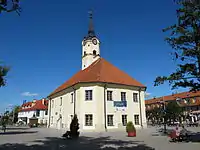 Baroque town hall in Bielsk Podlaski, a former royal city of Poland and capital of Bielsk Land
Baroque town hall in Bielsk Podlaski, a former royal city of Poland and capital of Bielsk Land Hajnówka is notable for its proximity to the Białowieża Forest, the biggest primaeval forest in Europe
Hajnówka is notable for its proximity to the Białowieża Forest, the biggest primaeval forest in Europe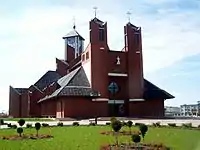 Sanctuary in Sokołów Podlaski
Sanctuary in Sokołów Podlaski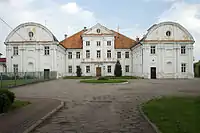 Congregation of the Mission Monastery in Siemiatycze
Congregation of the Mission Monastery in Siemiatycze
References
- Paul Robert Magocsi. Historical Atlas of Central Europe: From the early fifth century to the present. Thames & Hudson, 2002.
- William Fiddian Reddaway. The Cambridge History of Poland: Volume 2. 1971.
- Zigmantas Kiaupa. The History of Lithuania. Baltos Lankos, 2005. p.52.
- Zenon E. Kohut, Bohdan Y. Nebesio, Myroslav Yurkevich. Historical Dictionary of Ukraine. Scarecrow Press, 2005.
- Jerzy Kłoczowski. A History of Polish Christianity. Cambridge University Press, 2000, p.268. - Bedford, Neal (2008). Poland. Lonely Planet. pp. 138–139. ISBN 978-1-74104-479-9.
- Chorzempa, Rosemary A. (2009). Polish Roots. Genealogical Publishing Com. pp. 84–85. ISBN 978-0-8063-1378-8.
- Oskar Halecki; W: F. Reddaway; J. H. Penson. The Cambridge History of Poland. Cambridge University Press. pp. 363–364. ISBN 978-1-00-128802-4.
- The Gate of Podlasie
- Podlasie Archived 2013-12-11 at the Wayback Machine
- Introducing Mazovia & Podlasie
- Podlasie24
- Podlasie Jazz Festival - Volodymyr Kubijovyč. "Podlachia". Encyclopedia of Ukraine. Retrieved 23 February 2020.
- Stan badań archeologicznych na pograniczu polsko-białoruskim od wczesnego średniowiecza po czasy nowożytne. Białystok: Muzeum Podlaskie. 2006. ISBN 83-87026-70-0.
- "Первая всеобщая перепись населения Российской Империи 1897 г. Распределение населения по родному языку, губерниям и областям". www.demoscope.ru (in Russian). Демоскоп Weekly. Retrieved 22 February 2020.
- "Первая всеобщая перепись населения Российской Империи 1897 г. Распределение населения по родному языку и уездам 50 губерний Европейской России". www.demoscope.ru (in Russian). Демоскоп Weekly. Retrieved 22 February 2020.
- Barwiński 2005, p. 1.
- Barwiński 2005, p. 9.
- Barwiński 2005, p. 6, 18.
- Arkushyn 2019, p. 116-117.
- Barwiński 2005, p. 7.
- Barwiński 2005, p. 12.
- Arkushyn 2019, p. 118.
- Barwiński 2005, p. 8, 18.
- Barwiński 2005, p. 14.
- Arkushyn 2019, p. 115-116.
- Barwiński 2005, p. 17-18.
- Lesiv 1997, p. 291.
- Arkushyn 2019, p. 116.
- Arkushyn 2019, p. 115.
- Lesiv 1997, p. 368.
- Lesiv 1997, p. 283.
- http://www.polskawliczbach.pl/Miasta
Sources
- Arkushyn, H. L. (2019). "Хахлацька мова на Підляшші" [Khakhatska language in Podlachia] (PDF). Українська мова (in Ukrainian). Луцьк (1): 115–125. doi:10.15407/ukrmova2019.01.115. ISSN 1682-3540. Retrieved 23 February 2020.
- Barwiński, Marek (2005). "Struktura narodowościowa i językowa mieszkańców południowo-wschodniej części województwa podlaskiego – porównanie wyników badań terenowych i Narodowego Spisu Powszechnego". Pogranicze (in Polish). Wydawnictwo Uniwersytetu w Białymstoku: 67–84. hdl:11089/3855. ISSN 1230-2392.
- Lesiv, Mykhailo (1997). Українські говірки в Польщі [Ukrainian subdialects in Poland] (in Ukrainian). Український архів.
